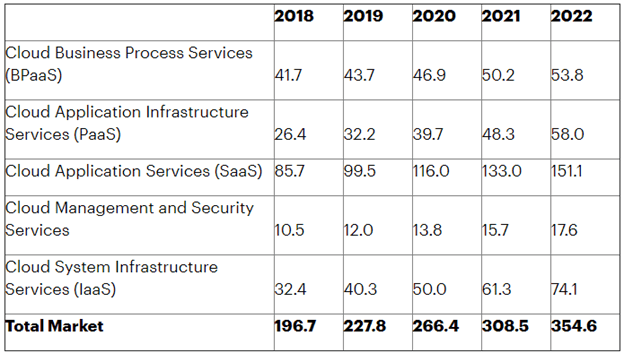To many people, Cloud Computing as a concept is hard to grasp. Whether they think of literal clouds in the sky or just giant computers or servers in a tower somewhere is inconsequential. What is consequential, however, is the fact that this new computing paradigm has transformed how businesses operate online.
According to Gartner Forecasts, the cloud industry is expected to be worth $308.5 billion by the end of 2021. The SaaS, PaaS, IaaS services are collectively responsible for the exponential growth of the Cloud industry over the past few years.

Cloud Services Revenue Forecast by Gartner
Undoubtedly, this growth is a sign that companies and even individuals are moving to the cloud due to a variety of reasons. These reasons include security, accessibility, and lots of storage space. So, let’s dig into the details of how Cloud technology is making an impact in our world, present and future.
1) Rise of Serverless Architecture
Many tech companies used to spend their resources and time building an infrastructure for their software applications and physical systems. They stored their data on traditional, on-site servers that were not very secure and scalable. But once the Cloud emerged as an option, businesses switched and built their IT resources using serverless architecture.
Thanks to all its advantages, serverless computing gained traction. Given that it can get higher availability, scalability, and cost savings without the need of high-level cloud computing expertise, it is the perfect solution for entrepreneurs, startups, small and medium businesses, and even enterprise companies.
Terms like “dynamic”, “service-oriented”, “flexible”, “on-demand resources”, and “automatic scaling” were rarely used to describe on-premises IT environments. Curiously, these are the main characteristics of serverless architecture. No wonder it is a no-brainer to make the switch to the Cloud!
It is estimated that the size of this new tech market will grow to approximately $8 billion by 2021. Cloud entirely revolutionized this traditional system with serverless Cloud architecture where companies are allowed to scale without spending more resources. Many third-party cloud providers offer these services, such as AWS, GCP, and Azure.
Most big players in the tech industry have already shifted to this model while many others are partially shifting to this model for better security, accessibility, and scalability (a.k.a., Hybrid Cloud computing). And even if the shift is just partial, the operational costs for businesses investing in the Cloud are still significant.
2) Exponential Growth of AI
If the concept of Cloud Computing is mystifying to most people, then Artificial Intelligence (a.k.a., AI) could seem beyond comprehension. This new field of computer science focuses on creating machines that can think and learn from their experiences to make decisions.
This means an AI program can both learn and apply knowledge, as well as accomplish tasks that were once done by humans (computer vision, speech recognition & natural language processing, and complex problem-solving, like breaking the most secure, modern encryptions in a matter of minutes). And when these AI (which are computer algorithms using mathematics and logic to perform data-processing tasks) are run in the Cloud, the possibilities and implementations for this technology are endless.
That is why AI Cloud Computing is a hot topic in the tech industry. Both of these technologies merge to form an environment where data analysis is taken to new heights. In a cloud environment, AI uses all the historical data to analyze the trends and patterns to extract useful recommendations for decision-making.
What makes AI Cloud Computing so special is that companies can use maximum cloud resources to process their data without any interruption. This is the reason why both of these technologies together are so powerful.
3) Increased Data Management Capabilities
Humans create trillions of gigabytes of data every day. This data has to go somewhere to be processed. It needs to be stored, processed, and then managed to get the desirable results. The traditional ways are not so good in managing terabytes of data. Also, every type of data has to be treated differently.
There are sensitive datasets such as passwords that need better security, hence a cloud password manager for business is a reliable solution on an individual or organizational level. The cloud is the only way to smoothly handle all this data efficiently.
4) 100% Digital Infrastructure with Cloud
You can optimize your business’ IT architecture and operational model by modernizing your company’s network, application hosting, and end-user environments. The smartest way to do this is by making the shift (fully or partially) to serverless computing. This will reduce costs and risks, and at the same time result in increased agility, productivity, and efficiency.
In the next 20 to 30 years, the world will be digitalized with technologies like IoT. These millions of interconnected devices also rely on Cloud-based systems to effectively control and centralize the networking and data processing functionalities of the devices. Smart Cities are also introducing automation in every aspect of our daily life and all of the infrastructures that are to be laid down on the Cloud.
5) Quantum Computing for the Public Consumer
Quantum computing was only limited to big organizations that processed large amounts of data to extract useful information. However, the horizons for Quantum Computing are expanding with the evolving Cloud technologies.
In 2019, IBM released its quantum computer as a cloud service. Users can remotely access this powerful machine to run all their programs or analysis that requires exponentially high computing power.
Conclusion
We might not remember the IBM 7090 mainframe computers used by NASA to perform space mission calculations, but we know for a fact that computers have come far! With the rise of serverless architecture, the rise of AI, increased data management capabilities, full digital infrastructure, and quantum computing, the Cloud has exceeded every one of humanity’s expectations for its digital future.
But the future is now. The Cloud is part of our reality, even if it is something we could not even conceive of 20 years ago. And it is definitely more than a trend. The Cloud has established itself as a brand-new space full of possibilities and opportunities in the world of Computer Science and Information Technology, and it has come to stay.

































